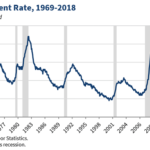4% Unemployment Makes Employee Engagement CRUCIAL
I believe we have the capability to innovate our way out of anything. The problem is, we generally don’t act until there is a crisis. When unemployment was in double figures, there was no compelling reason to pay attention to the importance of engaging employees. After all, where were they going to go? It was tough “out there” and they were unlikely to walk out the door.
Even if you’re a kind soul who truly cares about your team, there’s still a good chance you have not been giving enough attention to engaging your employees. You’re busy; you have a lot to do.
 Consider this your wake-up call. Your employees now have many options, especially your top performers. Unemployment is at 4%. Take your team for granted at your peril. There IS a crisis; time to innovate.
Consider this your wake-up call. Your employees now have many options, especially your top performers. Unemployment is at 4%. Take your team for granted at your peril. There IS a crisis; time to innovate.
At a time of year when most organizations are looking at budgets, an equally important task is to look just as closely at your employee engagement. There are numerous ways to measure it: use of employee benefits, mistakes made, customer accolades versus complaints, productivity, etc. My guess, however, is that you already know whether your employees are engaged. You can tell by the energy (or lack thereof) at your work place.
If there is one thing you can do this year to ensure growth and/or increased productivity, it is to focus on ways to engage your team more fully. Unfortunately, this is often not even on most leaders’ radar. It’s too easy to decide that it’s hopeless– people will be people – I can’t do anything about whether or not they are engaged.
How do you know? Have you even tried?
First of all, you get more of what you focus on. The moment you shift your focus from, “What’s the use?” to “Let’s see what we can make happen,” you will begin to see an uptick in engagement. Add to that some simple approaches:
- Before going straight to your work area at the beginning of your day, make an effort to greet everyone on your team. If they respond with a puzzled look and ask, “Who are you again?” you know it’s a bigger problem than you feared.
- “Catch” people doing something right.
- Say “thank you” and be specific about what you’re thanking them for.
- Write them up for doing something well versus writing them up for mistakes.
These are just a few ways to engage your employees, there are many more. Those listed above don’t take a lot of time; they do take focus.
Why not try them out? Be innovative! What have you got to lose?
“There is a principle which is a bar against all information, which is proof against all arguments, and which cannot fail to keep a man in everlasting ignorance—that principle is contempt prior to investigation.” – Herbert Spencer
Or, as the old TV slogan encouraged us, “Try it; you’ll LIKE it!”
Humility & Leadership – Oxymorons?
“Humility is even more pleasing in people in whom arrogance would be understandable.”
― Mokokoma Mokhonoana
Two interesting pieces of information came across my computer screen today:
- Happiness at work may hinge on how you see your boss. At first I thought, “Well, d-uh!” but then I read the article more closely. According to a paper published by the National Bureau of Economic Research, employees who think of their supervisors as partners report significantly higher levels of happiness than those who think of their managers as bosses.
- Humility, as a desirable trait, is making a comeback! Some companies are even using it as part of their criteria for hiring, according to a report in The Wall Street Journal. Additionally, three recent studies revealed that leaders who are considered humble “inspire close teamwork, rapid learning, and high performance in their teams.” Employees who display this trait have been found to be less likely to be absent from work, or quit. Unfortunately, they are also less likely to call attention to themselves, which means that their positive qualities might go unnoticed.

According to the Merriam-Webster dictionary, humility is defined as follows: freedom from pride or arrogance.
It would be difficult to view an arrogant boss as a partner. We’re more likely to view him/her as someone to fear, or steer clear of. Neither encourages happiness or teamwork.
On the other hand, someone who is free from pride or arrogance is often what we term “approachable” or easy to be around. Each of us carries within us a desire to feel like our boss likes us and is “one of us;” that can only be fulfilled by someone who is humble.
Here are a few clues that your team sees you as someone to fear:
- You discover most errors; your team does not bring them to your attention
- Customer service problems are brought to you by customer complaints instead of proactively from your team
- Workplace energy is low when you’re around
- Team members avoid eye contact OR make eye contact in a belligerent or rebellious way
- You can just tell; you can’t put your finger on it but you know you make them uncomfortable.
If you’re interested in improving your likability, the best book I know is How to Win Friends and Influence People by Dale Carnegie.
If you’re not interested, consider this: A study conducted by economic researchers at the University of Warwick discovered happiness resulted in a 12% increase in productivity. On the other hand, unhappy workers were 10% less productive.
Besides, not wanting to improve your likebility is pretty arrogant, don’t you think?
Using Focused Attention to Increase Employee Engagement
It’s been awhile since I have written about the numerous benefits of harnessing The Law of Attraction to produce the results you want.
The Law of Attraction dictates that you get more of what you focus on. Unfortunately, this seems much clearer on days when we are attracting what we DON’T want. Expressions like, “It’s going from bad to worse,” or “I feel like I’ve got one foot nailed to the floor and I’m going in circles,” or my personal favorite, “Could you please check my back and see if someone stuck a target on it?” are all results of attracting by accident versus by design.
I had a morning like that. I had more items on my “to do” list than time to do them and I started the day gearing up for a battle. Well, The Law of Attraction did not let me down. My printer wasn’t doing what it should (or, more specifically, what I needed RIGHT NOW) and I got frustrated and angry. So, instead of changing my focus (by now I really should know to do this), I gritted my teeth and forged ahead, determined to conquer the day. As a result, when I went to make coffee (caffeine? Oh, yeah, THAT’LL help calm me down), I spilled half of it on the counter and the other half on the floor. Back to the printer—the problem got worse. Big surprise. But did I pay attention and take 5 minutes to change my focus? You know the answer because it’s what most of us do. We focus on the problem and it grows bigger and bigger.
Once the printing was done (having taken 3X as long as it should and twice the paper), I decided to have lunch and chill out. I made myself a sandwich and then went onto YouTube to find a video from The Voice, my favorite TV show.
This never fails to shift my focus to happier thoughts. I only had to watch 10 minutes of it to feel the tension relax in me and to start paying attention to the fact that I still had half a day left to get some important things done. Now, instead of tackling them while tense, a surefire way for more things to go wrong, I was in a good mood. From past experience, I know I will have an incredibly productive day. But let’s say for a moment that I don’t. At least I’ll have a day when I’m not wrapped so tight I feel like kicking a wall. That alone is worth the 10 minutes I took to shift my focus.
Think of your employees like that pesky printer. The more you focus on what they’re NOT doing, or that they’re doing it too SLOWLY, the more you will attract their poor performance. Not only that but you will infect them with your bad mood. So now, not only do you have a team that’s not producing what you want, everyone is so darn cranky! When people are cranky, they don’t engage; they use whatever protective behavior has served them in the past—sabotaging the work, hiding, calling in sick—you get the picture.
Experiment with the following: as you move about your day, begin focusing on what each team member has done or is doing right. Take a few seconds to fully absorb it. You don’t have to say a word! Not only will your point of attraction shift from non-productive to productive but your team will become more engaged—all without you saying a word. This is the power of deliberately harnessing The Law of Attraction by focusing your attention on what you want.
Or you could just kick a wall.
Employee Engagement–Unravelling the Mystery

Corporations spend thousands of dollars trying to figure out whether their employees are engaged and, if not, how to engage them.
There is an inexpensive, very simple, old-fashioned method for uncovering what your employees want and need in order to be engaged:
ASK THEM!!!
Engage is a verb. It involves interaction with something—a computer screen, a smartphone screen or—hey! Here’s a unique idea: HOW ABOUT A PERSON?
I know you’re super busy so I’ve put together a one-page listing of engaging questions to get you started: The Very Best Employee Engagement Questions
The Hedonic Treadmill’s Impact on Employee Engagement
When people think about how to increase Employee Engagement in organizations, they often focus on more tangible things like perks and environment. The thought is that, if you provide your team with good benefits and a beautiful place to work that includes fun things to do in between projects, they will then become more engaged in the work. How wonderful if that were so. All any company would need do is invest in a few ping-pong tables or a weekly massage therapist and voila! Employee Engagement!
I strongly encourage any or all of it. Benefits like good health insurance and 401(k)s help you to attract and keep talent. Recreational outlets are a means to address the tension and stress that can be part of a productive work environment. However, the problem with solely providing benefits and environmental “perks” as a means of engagement is that people get used to them very quickly. It’s known as the “hedonic treadmill.”
 Hedonic Treadmill – noun
Hedonic Treadmill – noun
The theory that humans continually adapt to bad and good circumstances and return to relative neutrality
Example: Lottery winners are the perfect example of the hedonic treadmill: within a year they generally return to their former level of happiness.
The Hedonic Treadmill recognizes that workers will quickly become used to the perks your organization so generously provides. Whether it’s great benefits or Freaky Fridays,” after awhile it becomes part of the “given” and the “expected” and they demand more. This is why you so often hear senior level executives lament, “It’s never enough for them.” (But these executives have their own version of The Hedonic Treadmill that often includes huge bonuses or better company cars.)
The Hedonic Treadmill inspires a strong argument for the three pillars of Employee Engagement that we advocate:
- Socratic Delegation
- Socratic Feedback, and
- Laughter in the Workplace.
No matter the benefits, toys or fun events provided, what has the strongest impact on Employee Engagement is the relationship between them and their direct supervisor. And those relationships play out most often when delegation and feedback are happening. When a supervisor delegates in a way that implies the team member doesn’t know what s/he is doing, de-motivation occurs. Likewise, when feedback is given in a way that leaves scars, employees mentally and emotionally check out. They do the bare minimum or start looking for other jobs.
We include laughter in the Employee Engagement equation because, as Victor Borge once famously said, “Laughter is the shortest distance between people.” When you have a supervisor you can laugh with, your engagement in the work increases. After all, you cannot laugh with someone unless you like him, even just a little. That makes it difficult to defy that person when s/he assigns you work.
If you are actively trying to increase Employee Engagement, which is at record lows across our nation, I invite you to pivot from the “give them more perks” conversation and toward the Leadership conversation.
No one ever performed their job better because of health insurance or foosball but there is a history of solid research that employees are more productive for a direct supervisor who is an effective and likable leader.
